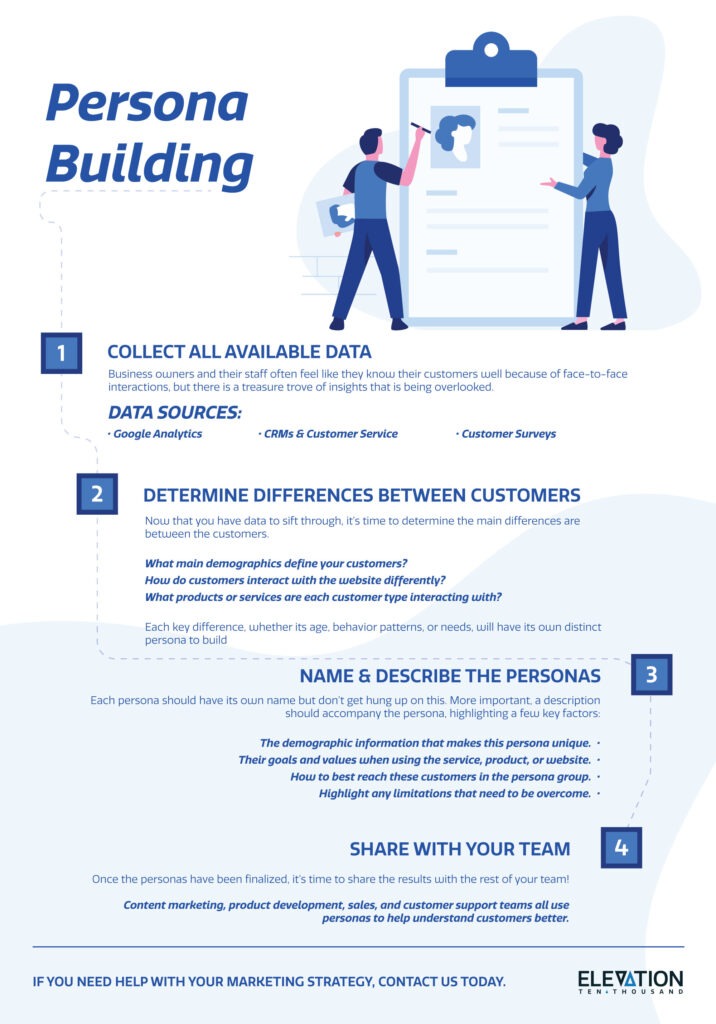How to Create Basic Buyer Personas
The ability to gain more insight into what customers are thinking is often what business owners want most.
Learning the characteristics of your customers can help develop a much more effective digital marketing strategy to drive more sales and engagement online.
To help achieve this goal, marketers develop buyer personas when developing strategies for SEO, paid media, and content.
Marketers aren’t the only ones who should be able to create buyer personas, business owners and brand managers should have this ability as well.
But first, it’s important to understand what a buyer persona is and how it can help your brand.
What Are Buyer Personas?
Buyer personas, sometimes referred to as marketing personas, are fictional representatives of your customers. This will help you to understand their values and goals when they consider using your service, product, or website.
Personas are built from real user data that has been collected from the business’ website and other sources — it should never be created based on assumption alone.
Each business should be able to develop multiple personas based on important demographic factors. Things like age, income, and geographical location are common factors that will allow you to start creating different personas.

Step 1: Collect All Available Data
Business owners and their staff often feel like they know their customers well because of face-to-face interactions, but there is a treasure trove of insights that is being overlooked.
Google Analytics
The first step is to look at the user data on the business’ website. By doing so, it allows you to understand how current and prospective customers are interacting online with the brand.
For example, if your business typically interacts face-to-face with customers in the 45 to 54 age range, you might find that there is a pocket of customers that exclusively use your website in the 25 to 34 range.
Free tools like Google Analytics offer demographic and on-page insights that can help collect the necessary data. If you are not currently using Google Analytics or a similar platform, it’s strongly suggested to create an account to use these tools today.
You can start grouping pages by the age of the user, which can help you understand what type(s) of users are more likely to visit specific sections of the website.
Marketers use other metrics such as average session duration and bounce rate to get a better understanding of how users are interacting with the site.
These metrics can be used to help you get a better understanding of what currently works and what doesn’t work for your customers.
CRMs & Customer Service
Most businesses use some form of client relationship management (CRM) tool to keep track of orders, support tickets, invoices, contracts, and much more.
CRM tools offer a variety of ways of grouping leads together to get a better understanding of your customer base.
Looking at this historical data can give you an understanding of how long the buyer journey takes for each customer type and what referral source — such as organic or paid, leads to the most customers.
If the business has a customer service department, this is the best way to get insights into common issues customers are trying to solve by using your product or service.
Talking to the agents and getting a list of common issues is a good start when building buyer personas.
Customer Surveys
Another tool business owners can use to get a better understanding of their customers are surveys. Surveys can be used to learn how customers are finding the business, using the website, and what they think of the brand.
Crafting good surveys is an art form in and of itself, but you can still create basic surveys to start collecting customer data if other resources are limited.
It can be as simple as crafting an email that contains a survey or supplying the customer service representatives with a few questions to ask while speaking with the customer.
Step 2: Determine the Differences Between Customers
Now that you have data to sift through, it’s time to determine what the main differences are between the customers.
What main demographics define your customers? How do customers interact with the website differently? What products or services are each customer type interacting with? These are some basic questions to help figure out what makes each customer different.
These differences are key when developing content, optimizing landing pages and KPIs, and identifying potentially underserved markets.
Each key difference, whether it is age, behavior patterns, or needs, will have its own distinct persona to build.
Step 3: Name & Describe the Personas
It might sound a bit silly to come up with names for these fictionalized personas but naming the identities helps to easily communicate these personas with the rest of your team.
Each persona should have its own name — but don’t get hung up on this. More important, a description should accompany the persona, highlighting a few key factors:
- The demographic information that makes this persona unique.
- Their goals and values when using the service, product, or website.
- How to best reach these customers in the persona group.
- Highlight any limitations that need to be overcome.
Lastly, it might be important to come up with a separate list of anti-personas. These would be groups of individuals you do not want to target, especially if the business offers a more niche product or service not available to everyone.
Step 4: Share with the Rest of Your Team
Once the personas have been finalized, it’s time to share the results with the rest of your team.
How personas can be used by the rest of your team:
- Content marketing teams can use personas to create effective strategies. Personas help to focus keyword research efforts, general tone, and user intent as a reference when crafting content.
- Product development teams use buyer personas when building product roadmaps. Personas help identify and prioritize changes based on what customers need the most.
- Sales teams use personas to build rapport with potential customers. By understanding what the potential customer is dealing with, the sales team will be much more effective.
- Customer support teams can use personas to better serve existing customers. Being trained on the problems customers are currently trying to solve with the product and the frustration it causes when things don’t work out, the support team will be able to show more empathy.
The best way to reach new customers and grow the brand is to work with a trusted agency with years of digital marketing experience. If you need help with your marketing strategy, contact us today.





